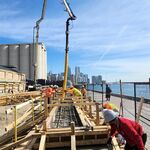aquateam
Active Member
According the the people I talked to from tConet they said Iphones take the longest to cont to it and that Androids are generally faster. Most of the time I have no problem connecting to it quick enough for apps to send stuff through or for part of a youtube video to upload.
I have an iPhone 6 so maybe that's why. I basically don't have any internet access for my entire TTC trip unless we're held at a station for a crew changeover.





